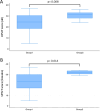Long-term effects of SARS-CoV-2 infection in patients with and without chemosensory disorders at disease onset: a psychophysical and magnetic resonance imaging exploratory study
- PMID: 38441790
- PMCID: PMC11082021
- DOI: 10.1007/s10072-024-07429-4
Long-term effects of SARS-CoV-2 infection in patients with and without chemosensory disorders at disease onset: a psychophysical and magnetic resonance imaging exploratory study
Abstract
A preserved sense of smell and taste allows us to understand many environmental "messages" and results in meaningfully improvements to quality of life. With the COVID-19 pandemic, it became clear how important these senses are for social and nutritional status and catapulted this niche chemosensory research area towards widespread interest. In the current exploratory work, we assessed two groups of post-COVID-19 patients who reported having had (Group 1) or not (Group 2) a smell/taste impairment at the disease onset. The aim was to compare them using validated smell and taste tests as well as with brain magnetic resonance imaging volumetric analysis. Normative data were used for smell scores comparison and a pool of healthy subjects, recruited before the pandemic, served as controls for taste scores. The majority of patients in both groups showed an olfactory impairment, which was more severe in Group 1 (median UPSIT scores: 24.5 Group 1 vs 31.0 Group 2, p = 0.008), particularly among women (p = 0.014). No significant differences emerged comparing taste scores between Group 1 and Group 2, but dysgeusia was only present in Group 1 patients. However, for taste scores, a significant difference was found between Group 1 and controls (p = 0.005). No MRI anatomical abnormalities emerged in any patients while brain volumetric analysis suggested a significant difference among groups for the right caudate nucleus (p = 0.028), although this was not retained following Benjamini-Hochberg correction. This exploratory study could add new information in COVID-19 chemosensory long-lasting impairment and address future investigations on the post-COVID-19 patients' research.
Keywords: MRI brain volumetric analysis; Post-COVID-19 patients; Smell/taste impairment.
© 2024. The Author(s).
Conflict of interest statement
The authors declare no competing interests.
Figures




Similar articles
-
Long-Term Taste and Smell Outcomes After COVID-19.JAMA Netw Open. 2024 Apr 1;7(4):e247818. doi: 10.1001/jamanetworkopen.2024.7818. JAMA Netw Open. 2024. PMID: 38652477 Free PMC article.
-
Six-Month Psychophysical Evaluation of Olfactory Dysfunction in Patients with COVID-19.Chem Senses. 2021 Jan 1;46:bjab006. doi: 10.1093/chemse/bjab006. Chem Senses. 2021. PMID: 33575808 Free PMC article.
-
More Than Smell-COVID-19 Is Associated With Severe Impairment of Smell, Taste, and Chemesthesis.Chem Senses. 2020 Oct 9;45(7):609-622. doi: 10.1093/chemse/bjaa041. Chem Senses. 2020. PMID: 32564071 Free PMC article.
-
Sudden onset, acute loss of taste and smell in coronavirus disease 2019 (COVID-19): a systematic review.Acta Odontol Scand. 2020 Aug;78(6):467-473. doi: 10.1080/00016357.2020.1787505. Epub 2020 Aug 7. Acta Odontol Scand. 2020. PMID: 32762282
-
Smell and taste disorders in COVID-19: From pathogenesis to clinical features and outcomes.Neurosci Lett. 2021 Mar 23;748:135694. doi: 10.1016/j.neulet.2021.135694. Epub 2021 Feb 15. Neurosci Lett. 2021. PMID: 33600902 Free PMC article. Review.
References
-
- Hopkins C, Kelly C. Prevalence and persistence of smell and taste dysfunction in COVID-19; how should dental practices apply diagnostic criteria? BDJ In Pract. 2021;34:22–23. doi: 10.1038/s41404-021-0652-4. - DOI
MeSH terms
Grants and funding
LinkOut - more resources
Full Text Sources
Medical
Miscellaneous

